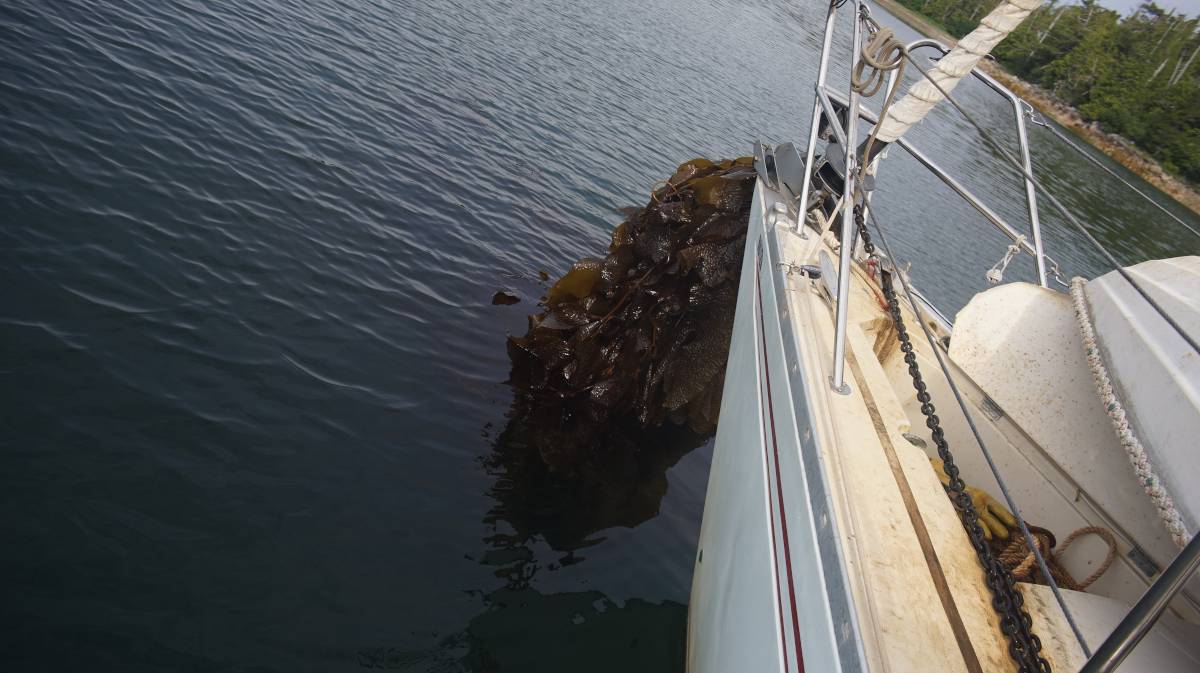anchoring
When anchoring, use a scope of 1:3 when using all chain, or 1:4 if possible. More scope means less vertical strain on the anchor, and less chance of unsetting it. The longer scope is not always possible in tighter anchorages, which is why having a considerable length of chain will increase horizontal tension. A minimum of 15 m (50 ft) chain linked with at least 90 m (300 ft) of nylon rode is recommended. A nylon rode with a short length of chain requires a bigger scope of 1:7, although it is difficult to find places to anchor that will allow for that much swing room, it depends on where you sail. Our home waters in the Salish Sea rarely allow for that kind of scope, especially during peak summer sailing season.
Anchoring etiquette. Don't anchor too close to your neighbor, especially if the neighboring boat is a motor boat, or much larger yacht. Boats orbit their anchors differently, especially lighter vessels. A lighter boat, with an all-nylon rode might "dance" around its anchor more and require more space.
When coming to anchor in a bay to find other boats already occupying it, observe how they are set up, if they are on nylon rode or chain, and how far apart they are spaced. If unsure about the set up of a neighboring boat, ask, the last thing you want is to set your anchor too close to theirs. Some boats may have a stern anchor, which means they won't swing, and so if you are near, you must do the same or you will swing into them. Anchor behind other boats, or well in front if there is enough space, and try to stagger your spacing to one side or the other to avoid being directly off someone’s bow.
Water depth. We prefer to anchor in waters no deeper than 11 m, to make it easier to retrieve our anchor. We have found plenty of anchorages in the South Pacific in that depth range. Also, in many places in French Polynesia, The Marshall Islands, Fiji and Tonga, they recommend the use of mooring buoys to keep from damaging coral reefs on the seafloor.
When sailing in Northern BC(see western canada) and us se alaska we ended up having to anchor in deeper waters, sometimes in 23 m(at high water). The tides in this part of the world can reach as high as 4.8-6.4 m(16-21 ft). We held fine in all of the anchorages we visited with 1:3 scope with 30 m of chain and an oversized anchor-also, our boat is light. In heavy weather, we generally aim for 1:4. There isn't just one combination of rode and anchor that can keep your boat safe, what works depends on the size/weight of the boat, the size/type of anchor, and the kind of sea floor(mud, sand, rock etc).
Anchor retrieval without a windlass. When in deeper waters, we often had to use a chain hook led back to a cockpit winch(see no windlass) to pull our chain up. To haul up long stretches of nylon rode in deep waters, we would tie a rope loop to the nylon rode using a prusik knot(a friction knot that tightens under load), tie a bowline to the loop and lead that back to a cockpit winch. This system worked well enough for us, but hauling up the anchor this way is not a fast process, it only requires a good cockpit winch.
Sea floor debris. Sometimes, when anchoring, you may find it difficult to pull up the anchor from the sea floor. The anchor may have snagged some debris. In places where others have reported that the sea floor has debris, tie a float to the head of your anchor so that you haul it up with it in case it gets stuck. The line to the float needs to accomodate the water depth. We used this system while anchored in Frances Bay, a place where the sea floor is known to have old logging cables.
Some anchorages are full of kelp, it may be more effort to retrieve an anchor but it is not impossible. Kelp is very thick, it is shocking how difficult it is to rip apart with your hands. If anchoring in kelp-prone areas, keep a good serrated knife at hand.

Read about our anchoring setup.